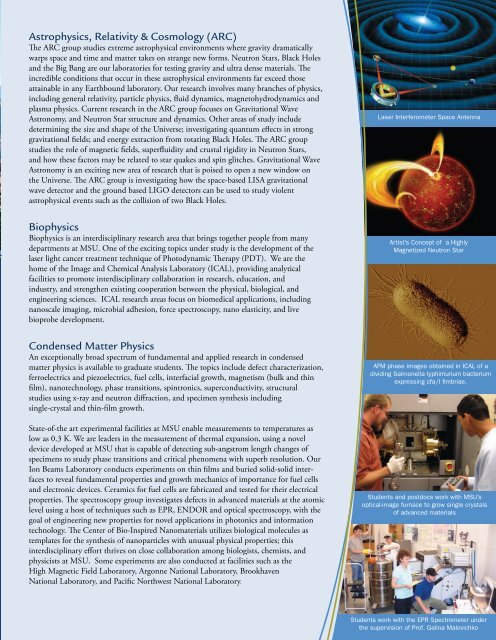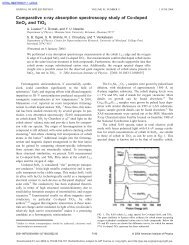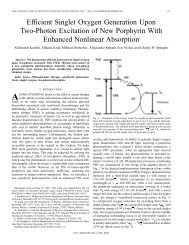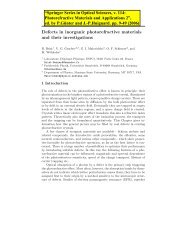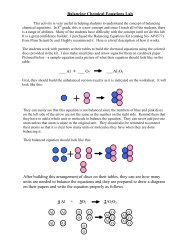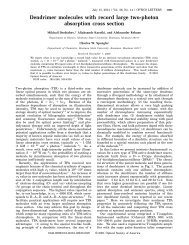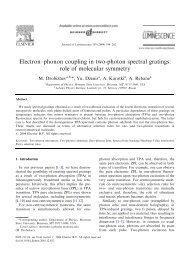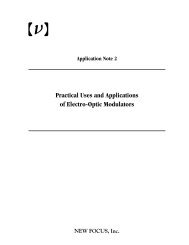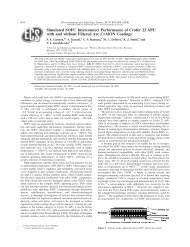Graduate Brochure - Department of Physics - Montana State University
Graduate Brochure - Department of Physics - Montana State University
Graduate Brochure - Department of Physics - Montana State University
Create successful ePaper yourself
Turn your PDF publications into a flip-book with our unique Google optimized e-Paper software.
Astrophysics, Relativity & Cosmology (ARC)<br />
The ARC group studies extreme astrophysical environments where gravity dramatically<br />
warps space and time and matter takes on strange new forms. Neutron Stars, Black Holes<br />
and the Big Bang are our laboratories for testing gravity and ultra dense materials. The<br />
incredible conditions that occur in these astrophysical environments far exceed those<br />
attainable in any Earthbound laboratory. Our research involves many branches <strong>of</strong> physics,<br />
including general relativity, particle physics, fluid dynamics, magnetohydrodynamics and<br />
plasma physics. Current research in the ARC group focuses on Gravitational Wave<br />
Astronomy, and Neutron Star structure and dynamics. Other areas <strong>of</strong> study include<br />
determining the size and shape <strong>of</strong> the Universe; investigating quantum effects in strong<br />
gravitational fields; and energy extraction from rotating Black Holes. The ARC group<br />
studies the role <strong>of</strong> magnetic fields, superfluidity and crustal rigidity in Neutron Stars,<br />
and how these factors may be related to star quakes and spin glitches. Gravitational Wave<br />
Astronomy is an exciting new area <strong>of</strong> research that is poised to open a new window on<br />
the Universe. The ARC group is investigating how the space-based LISA gravitational<br />
wave detector and the ground based LIGO detectors can be used to study violent<br />
astrophysical events such as the collision <strong>of</strong> two Black Holes.<br />
Biophysics<br />
Biophysics is an interdisciplinary research area that brings together people from many<br />
departments at MSU. One <strong>of</strong> the exciting topics under study is the development <strong>of</strong> the<br />
laser light cancer treatment technique <strong>of</strong> Photodynamic Therapy (PDT). We are the<br />
home <strong>of</strong> the Image and Chemical Analysis Laboratory (ICAL), providing analytical<br />
facilities to promote interdisciplinary collaboration in research, education, and<br />
industry, and strengthen existing cooperation between the physical, biological, and<br />
engineering sciences. ICAL research areas focus on biomedical applications, including<br />
nanoscale imaging, microbial adhesion, force spectroscopy, nano elasticity, and live<br />
bioprobe development.<br />
Condensed Matter <strong>Physics</strong><br />
An exceptionally broad spectrum <strong>of</strong> fundamental and applied research in condensed<br />
matter physics is available to graduate students. The topics include defect characterization,<br />
ferroelectrics and piezoelectrics, fuel cells, interfacial growth, magnetism (bulk and thin<br />
film), nanotechnology, phase transitions, spintronics, superconductivity, structural<br />
studies using x-ray and neutron diffraction, and specimen synthesis including<br />
single-crystal and thin-film growth.<br />
<strong>State</strong>-<strong>of</strong>-the art experimental facilities at MSU enable measurements to temperatures as<br />
low as 0.3 K. We are leaders in the measurement <strong>of</strong> thermal expansion, using a novel<br />
device developed at MSU that is capable <strong>of</strong> detecting sub-angstrom length changes <strong>of</strong><br />
specimens to study phase transitions and critical phenomena with superb resolution. Our<br />
Ion Beams Laboratory conducts experiments on thin films and buried solid-solid inter-<br />
faces to reveal fundamental properties and growth mechanics <strong>of</strong> importance for fuel cells<br />
and electronic devices. Ceramics for fuel cells are fabricated and tested for their electrical<br />
properties. The spectroscopy group investigates defects in advanced materials at the atomic<br />
level using a host <strong>of</strong> techniques such as EPR, ENDOR and optical spectroscopy, with the<br />
goal <strong>of</strong> engineering new properties for novel applications in photonics and information<br />
technology. The Center <strong>of</strong> Bio-Inspired Nanomaterials utilizes biological molecules as<br />
templates for the synthesis <strong>of</strong> nanoparticles with unusual physical properties; this<br />
interdisciplinary effort thrives on close collaboration among biologists, chemists, and<br />
physicists at MSU. Some experiments are also conducted at facilities such as the<br />
High Magnetic Field Laboratory, Argonne National Laboratory, Brookhaven<br />
National Laboratory, and Pacific Northwest National Laboratory.<br />
Laser Interferometer Space Antenna<br />
Artist’s Concept <strong>of</strong> a Highly<br />
Magnetized Neutron Star<br />
AFM phase images obtained in ICAL <strong>of</strong> a<br />
dividing Salmonella typhimurium bacterium<br />
expressing cfa/I fi mbriae.<br />
Students and postdocs work with MSU’s<br />
optical-image furnace to grow single crystals<br />
<strong>of</strong> advanced materials<br />
Students work with the EPR Spectrometer under<br />
the supervision <strong>of</strong> Pr<strong>of</strong>. Galina Malovichko


